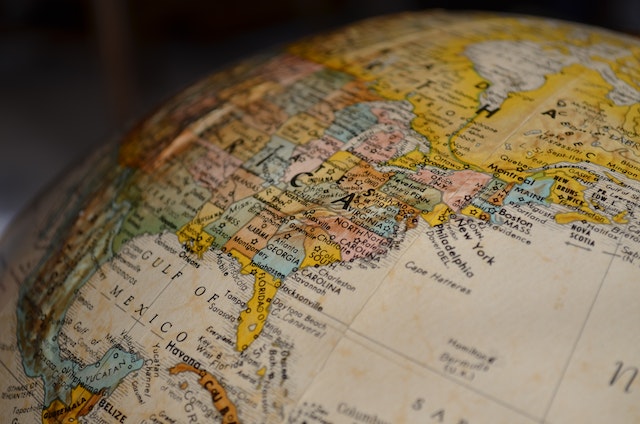
When were latitude and longitude invented? Latitude in about 600 BC and longitude in AD 1736.
Latitude are the horizontal lines that measure your distance to the north or the south of the equator. Longitude are the vertical lines that measure your distance to the east or west of 0, which has been set as the line that runs through Greenwich in London. If you want to know accurately where you are anywhere in the world, you need to know your latitude and your longitude. For example, if you were in the Empire State building in New York City, you would be at 40° 44′ 55.7412” North and 73° 59′ 7.5408” West. The first number is the latitude and the second number is the longitude. The Earth is a sphere, so it has 180° in the northern hemisphere and 180° in the southern hemisphere. It has 180° to the west of 0° longitude and 180° to the east of 0° longitude. Each degree is broken up into 60 minutes and each minute is broken up into 3600 seconds. So, the location of the Empire State Building is 40 degrees and 44 minutes, 55.7412 north of the equator and 73 degrees and 59 minutes, 7.5408 seconds west of 0°.
Knowing latitude and longitude make it very easy to know where you are on Earth, but working them out hasn’t always been as easy as it is now. Latitude is technically easier to work out that longitude because it can be worked out using the sun or the stars. The Polynesians, the Phoenicians, and many other seafaring groups of people worked out latitude in this way. The Phoenicians had a system of latitude worked out by 600 BC. If you know where the sun is at noon, or if you know where Polaris, the North Star is, you can generally work out your latitude. However, these general calculations were only useful with all of the other navigation methods that those people possessed. If you wanted to know your latitude more precisely it was difficult to do.
Three different devices were invented to try to work out the latitude more accurately. These were the quadrant, the astrolabe, and the sextant. The quadrant was invented by Islamic astronomers in the Middle Ages. A quadrant could be used to calculate the angle between the observer and a star or the sun. A sextant was a similar device. The sextant was invented in 1731 and used two mirrors to measure the angle of the sun at noon or the north star. Using these devices, a sailor could know their latitude on the ocean, although there were a lot of technical problems with each device and the calculations were incredibly difficult.
If you know your latitude, that is great, but the 50° latitude north passes through France, Poland, Russia, Canada, and the UK. Knowing your longitude can tell you which of those places you are in, but longitude was a lot more difficult to calculate. People had survived with latitude for centuries because knowing your longitude wasn’t overly important. However, once the age of exploration and sea-borne trade took off, it became more important.
Longitude is difficult to calculate. There are no heavenly bodies that move north to south and can be used for navigation because the Earth rotates east to west. A Greek astronomer called Hipparchus came up with the idea of Longitude in about 150 BC and he set the 0 point as Rhodes, but there was no way to calculate it when you are on a ship. The only way it can be done is by comparing the local time at the 0° point with the local time on the ship at sea. That was impossible to do in a world without clocks.
The idea of using time to tell the location of the ship was thought up by Gemma Frisius, a Dutch mathematician, but there were no clocks that could be used to do it. An accurate pendulum clock had been invented in 1657 by Christiann Huygens, but a pendulum doesn’t work on a boat because the boat rocks on the waves, upsetting the pendulum. If the pendulum can’t swing freely, the clock can’t tell the time. Coupled with that, the clock would be affected by temperature differences, pressure, humidity, and salt corrosion. Many people thought that it would be impossible to make a clock that would work on a ship and lot of effort was put into a method to tell longitude by using heavenly bodies. This required incredibly complex calculations and observing the heavenly bodies was very difficult to do from a moving ship.
In the 18th century, Spain, France, and Britain all offered prizes to the person who could solve this problem. It took a long time, but finally in 1730, a clockmaker called John Harrison came up with the idea for a clock that used a spring instead of a pendulum. It took a lot of trial and error, but his clock was first tested successfully in 1736. By using it, a ship could accurately work out its longitude by comparing the time on deck to the time at Greenwich, which was 0°. Naval clocks were very expensive and not many ships could afford them. Longitude wouldn’t be comprehensively used until the invention of the radio in the early 20th century.
So, latitude has been calculated for over two thousand years, but longitude has only been possible to calculate accurately since fairly recently. And this is what I learned today.
Sources
https://en.wikipedia.org/wiki/History_of_longitude
https://en.wikipedia.org/wiki/Longitude
https://en.wikipedia.org/wiki/John_Harrison
http://www.thegreenwichmeridian.org/tgm/articles.php?article=9
https://www.techtarget.com/whatis/definition/latitude-and-longitude
https://sciencing.com/read-longitude-latitude-5083052.html
https://www.latlong.net/place/empire-state-building-new-york-usa-5312.html

Pingback: Why were alarm clocks the first consumer goods to stop being rationed during World War 2? - I Learned This Today